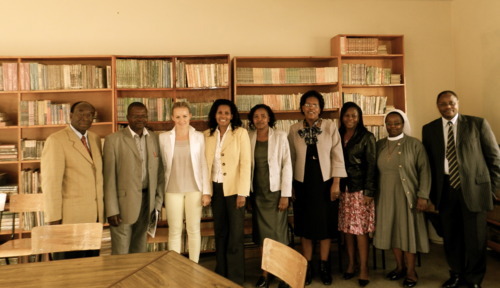
By Niccola Milnes and Rita Field-Marsam
Why Meet the Board?
After four months of establishing exactly how and in what we can meaningfully support the study of humanities and the reading culture at Precious Blood, we felt confident enough to present our intentions and solutions for Precious Blood to its Board of Directors and Parent Teachers Association (PTA). We wanted their seal of approval.
Previous Blood has a committed and distinguished board. Getting their endorsement and confirmation that our model adds value, in our view, would mean several things.
It would confirm that we were achieving our goal to tailor our donations so that they are not “add-ons” to school libraries but rather a respected recognized compliment and supplement to the school’s ongoing curriculum.
We also wanted to get feed back from the Board and the PTA because their views and buy in was crucial. Up until then, our model for Precious Blood was shaped by input from its teachers, students, and principal.
How did the Board Meeting Go?
It went on for much longer than expected. It stretched over 3 ½ hours with some grilling, pertinent questions and a lot of constructive hard talk. Some of the questions and concerns we had anticipated others we had not.
For example, they were concerned about us introducing new technology to the school, like interactive whiteboards, and it potentially taking focus off the set school’s curriculum and ultimately affecting how the girls perform in their exams. Precious Blood is renown for its high performing students that year after year rank top in the country. Understandably, they did not want to take any chances with the girls in their final year, whose KCSE final exam results, significantly determine their future.
The Board and the PTA asked:
- Would the learning curve of using Whiteboards take up time that students would be better off using to study?
- Are Whiteboards an unnecessary distraction?
- Can we do a trial and error with Whiteboards with classes in the lower school forms (grades) before we try it on the higher forms, so that the older girls are spared the distraction and can focus absolutely on their final exams, until the school, its teachers and students are familiar and effective users of Whiteboards?
With the persuasive and diplomatic help of Mrs Jacinta Akatsa, the Board and PTA were satisfied with my long list of pros versus cons for introducing interactive Whiteboards into the school. Jacinta explained that interactive Whiteboards would add value to the school’s teaching of the curriculum and their students and teachers would adapt very quickly to the new technology.
Here is what we did not anticipate:
The Board and PTA had reservations about our model’s reliance on a private school, namely Braeburn, for its teachers as coaches. They did not particularly like the idea of us bringing Braeburn instructors to their school to help train Precious Blood teachers on how to use interactive Whiteboards. What bothered them was the fact that Braeburn is a private school, which according to them usually means teachers and students with a different and uncomplimentary set of values and culture from public school communities. The co-mingling was described as a potentially “disruptive attitude to the mix”.
At an academic level, they were wary of the fact that Braeburn teachers were not knowledgeable about the Kenyan 8-4-4 curriculum and that they were not privy to the struggles and goals that public schools face because Braeburn is a very well funded school whose students follow, by choice, either the English A-level system or the International Baccalaureate program. The Kenya Fluorspar (rural) School – Braeburn exchange assuaged them and mitigated their concerns about this. In fact, we were able to demonstrate through this exchange that teachers, across the board, share an altruistic passion for education that translates into support and a willingness to collaborate to achieve the best results for students. Braeburn’s teachers fitted very well into Kenya Fluorspar’s conservative rural community and their expertise was a welcome contribution.
0
0
1
271
1551
field-marsham foundation
12
3
1819
14.0
After hours of talking, debating, deciding we were unanimous. We agreed that the Field-Marsham Foundation can assist Precious Blood. In the end of what felt like a grueling, I was relieved when we all laughed, shook hands, had tea and samosas.
What we learned, first hand, from this meeting was that:
- As a charity, you need buy-in and the support of school boards and PTA’s if you want your contribution to be meaningful and regarded as a worthwhile investment in the school
- If you wait to explain the donation after the fact, it can easily be interpreted as interference and outlandish
- Kenyans adhere to a very formal framework of appropriateness and etiquette. You need to confer with and get the blessings of those vested with authority
For all these reasons we strongly recommend that before making any significant donations to schools in Kenya donors do not overlook the importance of consulting the people in charge, basically, teachers, principals, school boards and PTAs.